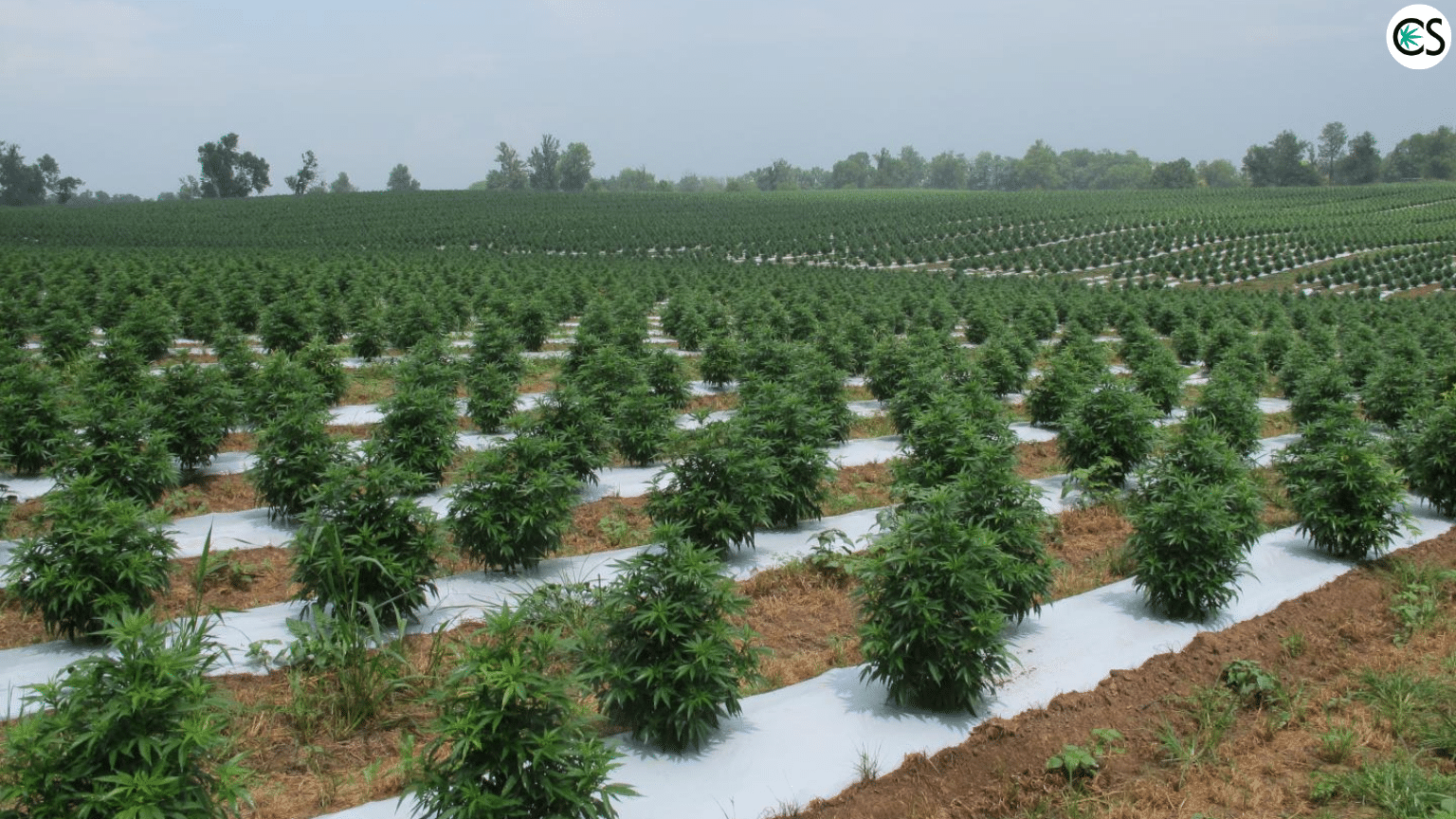
The money in hemp isn’t bad either.
By some estimates, hemp grown for CBD could be worth up to $30,000 an acre.
Plant a 10, 20, 50, or 100-acre hemp farm, and you’re looking at a rather lucrative crop.
Interested in learning how to grow hemp?
We bet you are.
Let’s dive right in.
The Basics of How to Grow Hemp
Seeing as the topic of growing hemp could encompass an entire book, here we’re simply going to cover the basics.
If you’re interested in learning how to grow hemp, but don’t know much about hemp or have the slightest idea of where to start, consider this written especially for you.
What is Hemp?
Like marijuana, hemp is a member of the Cannabis sativa L. plant species.
While both plants are from the same species, they contain a unique biological structure which makes them very different plants indeed.
While marijuana plants produce thick, dense buds and grow to be relatively bushy, hemp plants are tall and thin, don’t produce the buds that marijuana is famous for.
When you look at a hemp and marijuana plant side, there is no mistaking the difference between the two.
One of the biggest differences between hemp and marijuana, however, is the cannabinoid content each contain.
While marijuana can contain 5-30% THC (or more), hemp plants contain less than 0.3% THC.
What is Hemp Used For?
Hemp is primarily grown for a few different reasons.
It’s been grown for industrial purposes (such as for making fibers) for years.
It’s also grown for its nutritional seeds that can be eaten by themselves or used to make hempseed oil.
Most recently, hemp has been widely cultivated for CBD.
If you’re interested in learning how to grow hemp, it’s vital to determine what you’re interested in growing it for. Fiber? Seed? CBD?
Currently, growing hemp for CBD is making the biggest buzz.
Why?
Because the CBD industry has exploded and is estimated to be worth some $22 billion by 2022.
And now that it’s (almost) legal to grow in the US, there are plenty of people that want in on the action.
Let’s take a deeper look at the different categories of industrial hemp…something every would-be hemp farmer should know.
Fiber
For years, hemp has traditionally been grown for fiber.
Fiber types of hemp plants can be grown to produce paper, textiles, fuel, building materials, and much more.
Hemp grown for fiber is typically done on a large-scale production (including harvesting, processing, and transporting).
Seed/Grain
Hemp seeds are one of the most nutritional foods that exists.
Seed/grain types of hemp plants will typically contain a significantly lower cannabinoid content but are prized for their precious seeds.
These seeds are extremely delicate and must be harvested, processed, and transported with extreme care.
Storage is also vital to ensure the highest possible quality.
Cannabinoids
Cannabinoid-rich types of hemp are the most popular, as they contain significant amounts of cannabidiol (CBD) that can be used to make oil and various products.
Growing CBD hemp strains requires a certain level of mastery when it comes to cultivation in order to achieve the highest CBD levels, while keeping THC levels under 0.3%.
CBD grown for hemp typically only employs the female plant because male and female plants grown together will increase seed production while decreasing CBD levels.
The very first thing you should ask yourself when learning how to grow hemp is what type of hemp you want to grow.
You see, hemp plants grown for fiber, seed, and CBD are grown much differently.
CBD is extracted from the female hemp plants.
On CBD hemp farm, there are typically 1,000-1,600 plants grown per acre and all are tended to individually.
It’s grown similarly to marijuana, with the big difference being the levels of THC contained in the plant itself.
Both female and male plants are grown in industrial hemp farming.
There is a planting level of some 400,000 plants per acre.
Rather than harvested like marijuana, industrial hemp is reaped more like wheat.
The tops are typically harvested for seed, while the stalk and other fibers are used for countless industrial reasons.
So, exactly how does your hemp garden grow?
It all depends on the reason you’re growing hemp.
For all intents and purposes, we’ll focus on hemp grown for CBD.
How Does Hemp Like to Grow?
They don’t say cannabis grows like a weed for nothing.
If you’re interested in learning how to grow hemp, rest assured it’s one of the easiest plants to grow. Seriously, it will grow almost anywhere.
That being said, if you’re growing hemp to extract CBD, you want to ensure you’re growing the highest quality hemp possible.
We mentioned earlier that when grown for CBD extraction, hemp is grown similarly to marijuana.
Each plant is tended to individually and given the love and care it needs to thrive.
Quality cultivation practices can almost guarantee a quality harvest.
So what are the ideal conditions for growing hemp?
Before we look into that, it’s important to understand a bit about hemp seeds themselves.
After all, your hemp plants do need to grow from something.
Finding the Best Hemp Seeds or Clones
Currently, finding the right seeds poses a bit of a challenge to would-be hemp farmers.
There are plenty of seeds available throughout Europe and Canada, however, if these seeds are acclimated to the US is another question.
Hemp has been all but prohibited for almost a century.
This means you’re not going to be walking into your local feed store any time soon to pick up a bag of CBD hemp seeds.
Aside from hemp seeds from Europe and Canada, there are hemp seed varieties available online, but determining if they are genetically stable enough to ensure a consistent crop isn’t guaranteed.
According to Michael Bowman, founding chair of the National Hemp Association, it will “take another year” to ensure hemp farmers are getting a quality seed they can rely on.
Best Conditions for Growing Hemp
When learning how to grow hemp, it’s vital to keep in mind the most favorable conditions for cultivating your crop.
Sure, hemp will grow anywhere but there are conditions it prefers over others.
Check it out.
Soil
First things first.
Hemp does better in some types of soil than others. The first thing you’re going to want to do is get your soil tested.
You can buy a soil test online or take a soil sample to your local agricultural center for testing. Hemp prefers soil with a pH of 6-7.5.
Well-aerated, loamy soil is best and should contain rich organic matter, be extremely fertile, and supplemented with the recommended minerals if necessary to ensure plants will have exactly what they need through the growing season.
Sun
Hemp plants love sun.
That being said, hemp plants should be planted where they will receive the most sunlight possible.
While hemp will grow with as little as six hours of sunlight per day, if you want your plants to thrive, full sun is idea (think 12+ hours/day).
Seeds should be planted after the last danger of frost has passed, which is typically in early to mid-spring in most parts of North America.
Water
Hemp needs at least 20-30 inches of rainfall during its growth cycle.
If rainfall doesn’t meet these requirements, it will be necessary to employ proper irrigation.
Ample amounts of moisture are needed during germination. It’s important to also keep in mind that water absorption will increase each day until the beginning of the flowering stage.
According to extensive tests that were performed from 1975-1977, “soil moisture should not go below 80% of total moisture capacity during hemp ontogenesis.”
Pest/Disease Control
Any crop is subject to pests and disease, and hemp is no exception.
Keep in mind when learning how to grow hemp, that it is subject to a number of different garden pests and pathogens.
Disease is also something to keep in mind, particularly white and grey mold (which have historically been reported to infect and significantly impact industrial hemp production).
Other things to look out for are viruses, bacterial and fungal infections, root rot, and blight.
To date, there have not been any pesticides that are registered to use on hemp in the US.
Keep in mind that if you’re interested in growing organic hemp (which is extremely important for several reasons), the pesticides you use to control pests and/or disease should meet USDA National List of Allowed and Prohibited Substances.
To avoid disease build-up in hemp plants, a 4-year crop rotation is recommended.
Hemp Harvesting
Hemp grown for CBD extraction is typically harvested in early to mid-fall when cannabinoid levels are at their peak (think early to late October).
Much like the harvest of marijuana, hemp flowers are when ripe and full, then dried and optimally cured.
Typically, hemp plants are harvested at right around 4 months (or 16 weeks).
After harvest and curing your hemp plants, knowing where to sell your hemp (or send it for extraction to make your own products) is the next step.
While regulations have not been yet established for the legal hemp industry, expect a better understanding of where to sell wholesale hemp as new laws are set in place.
Understanding Hemp Cultivation Laws
We have truly stepped into one of the most exciting times in history.
After almost a century of prohibition, hemp has made a comeback. And it’s stepped into the mainstream spotlight.
While the 2018 Farm Bill essentially made hemp legal, regulations that govern the plant have yet to be established.
It’s up to individual states to address their own policy regarding hemp cultivation.
If you want to grow hemp, you’ll want to check the laws established in your state.
Click here for more information on State Industrial Hemp Statutes.
Hemp, Hemp Hooray…Growing Hemp is Here to Stay
We’re obviously overjoyed that hemp has made its way back into mainstream America.
Considering it was once illegal not to grow hemp in the US, then criminalized for almost 100 years, we’d like to think hemp has made one heck of a comeback.
If you’re interested in growing hemp, there’s never been a better time to learn everything you can.
Growing hemp for CBD extraction is an industry that’s set to explode in the next couple of years. Want to get in on it?
Best to get in now by learning all there is about growing hemp.
In the coming months, we’ll take an even deeper look into growing hemp to give you all the information we possibly can as we stay updated on rapidly changing policy, regulation, and cannabis cultivation laws in general.
Photo credit: GenCanna























